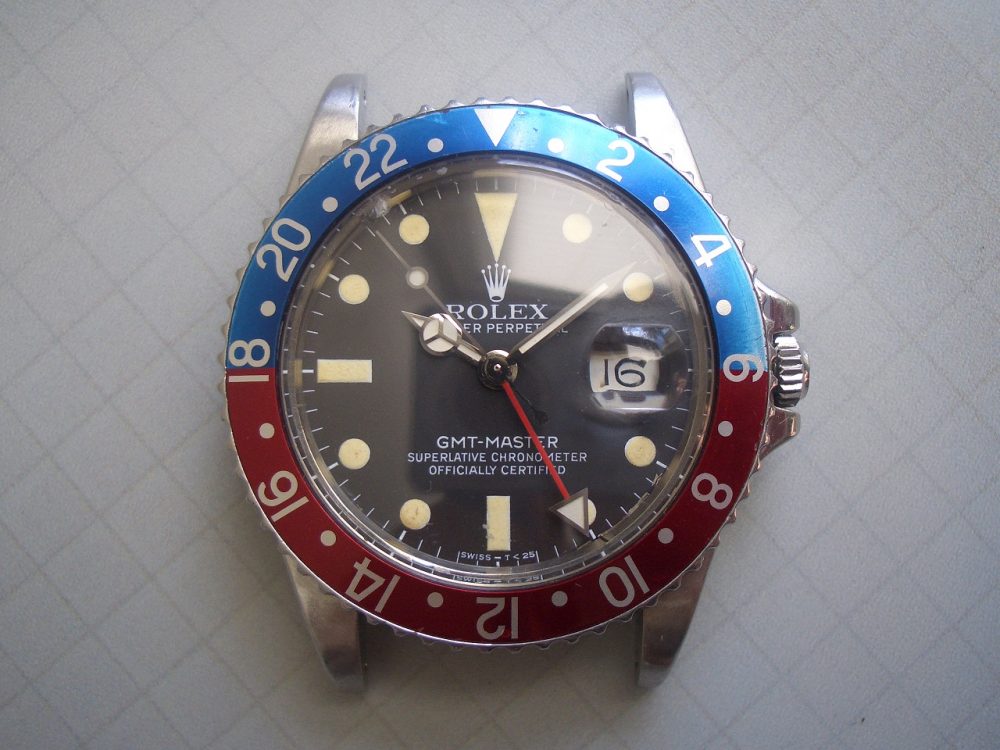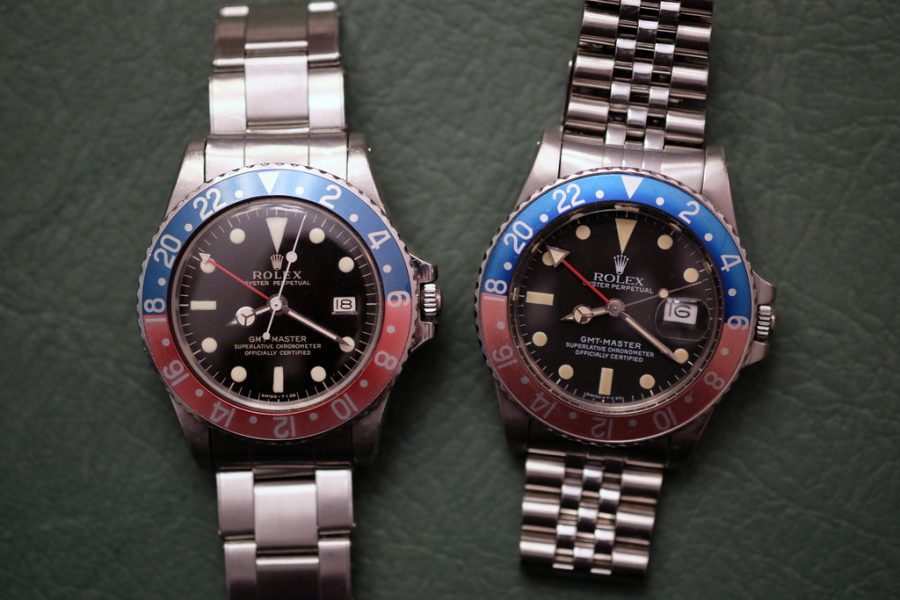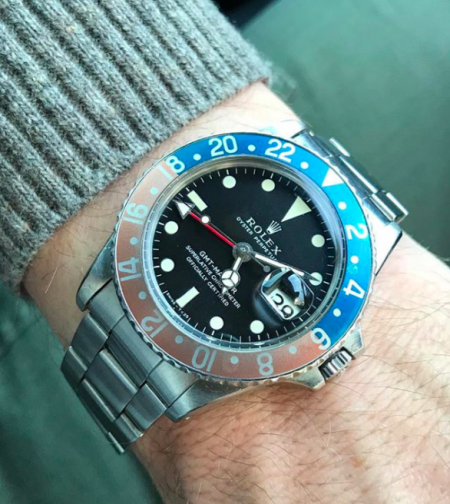
Rolex GMT-Master 16750 – Complete Guide
The Rolex GMT-Master has now been in production for more than half a century.
But over the course of this time, it has obviously evolved and been iterated many times, in true Rolex fashion.
Rolex is known for being a brand that develops watches that are meant to be truly helpful in their respective fields. The Submariner, for example, was developed to help divers not only keep track of the time underwater but most importantly, keep track of how much oxygen is left in the tank. The Daytona was developed to help racing drivers measure the average speed up to 400 kilometers per hour, and then, of course, there is the GMT-Master, which was developed upon the request of Pan Am, which looked for a tool that could help them keep track of two time zones simultaneously, as they started flying longer distances.

Today, the Rolex GMT-Master is one of the most popular models of Rolex. Recent models such s the GMT-Master II 126710BLRO on jubilee bracelet see a waiting list that is many years long, and naturally, the popularity of newer models also affects the price of older models – and vice versa of course.
As such, the prices of vintage GMT-Master watches on the secondhand market have steadily increased over the years, thus making the vintage GMT-Master watches more attractive and sought-after.
Over the years, Rolex has released a number of different GMT-Master watches, and they’ve released countless versions and iterations of the model, but in this article, we’re focusing on a specific watch – the Rolex GMT-Master 16760.
Background to the Rolex GMT-Master 16750
The GMT-Master 16750 is a model that didn’t live very long. In fact, it is a transitional model between an older, and a newer one, which featured new technical improvements.
Photo by @Bobkolican

To start at the very beginning, the Rolex GMT-Master was far from what it is today when it was first launched. When launching a new product, it is difficult to know how it will perform in the field, and it is only from constant testing that you identify areas where there is room for improvement. Also, at the time of release, it may be the best it can be, but over time, the technology evolves, and this means that as new methods, inventions, and technology come around, ultimately, you can create a better product, and this is exactly the case for the GMT-Master and any other Rolex model for that matter.
When Rolex realized what they could improve with their watches, they updated them, and this also gave room for transitional models such as the GMT-Master 16750.

The Rolex GMT-Master 16750 was released circa 1979/1980 (release dates back in the day were not as clear-cut as they are today) and was produced until 1988. This is quite a short production period for a Rolex model, and it is after its discontinuation that the watch has been identified as a transitional model.
And maybe most importantly is that due to the short production time, the 16750 is a model that exists in much fewer examples than other GMT-Master references, which thus naturally tends to affect their price and desirability.
The 16750 was not very different from its predecessor which had the reference 1675, but being transitional, the 16750 references featured a major difference, which was technical improvements to the movement which improved the way the watch worked.
In fact, the watch had 3 technical improvements from its predecessor. First off, the 16750 featured the caliber 3075. This movement beats at 28,800 BPH, compared to the previous 19,800. This means greater accuracy, and overall a more robust and modern movement.

The most important and notable update to the 16750 was that its movement now had a quick set date function, unlike the 1675, which made setting the date so much easier.
And lastly, the 16750 had a water resistance of 100M instead of the previous 50M.
Apart from these technical differences, the 1675 and 16750 are very similar, and it demands a well-trained eye in order to tell them apart.
Visual differences between Rolex GMT-Master 1657 and 16570
The visual differences between the two references are minimal.
The printed crown on the dial is slightly different, and the dial also varies slightly, but apart from this, it’s tricky to tell them apart.
One way to tell the difference is to see if the watch has a quickset date function, but another is to listen to the movement and hear if it is the fast-beating movement of the 16750 or the slower-beating 1657.

But the fact is that the new 16750 didn’t need to have enormous changes in its design, because the 1675 had been manufactured between 1959 and 1980, and during this long production period, people had come to love the looks and design. But the new updated functionality made the 16750 a watch that instantly became a hit.
During the course of its production which lasted for eight years, the 16750 had two dial variations. The first dial variation featured matte black dials with tritium hour markers – in true original fashion at the time. Back in the day, matte dials were essentially standard for Rolex and many other watch manufacturers, but then came the glossy black dials with indexes that included the white gold surrounds, as opposed to the previous indexes which were made in steel.
The catch, however, was that glossy dials were something very new at the time – something that Rolex hadn’t quite mastered the art of making glossy dials. In fact, these dials tended to become what we now know as ”Spider dials”, which meant that they more or less got cracks in them. As a result, these dials were often replaced, thus making a spider dial GMT-Master 16750 very rare to come by. Also, matte dials were often replaced with glossy ones during servicing.
Dials:
- Matte without white gold indexes. This has become extremely rare today.
- Glossy with white gold indexes identical to the newer GMTs.
In the year of 1986, Rolex switched the dial during production. The first model was introduced without ‘Date’-imprint on the dial, but later versions show this imprint.
Bezel of the Rolex GMT-Master 16750
As you know, the Rolex GMT-Master is available with different bezel options. In modern times, the GMT-Master II is available in an array of different bezel colors/color combinations, and even though the options were fewer, the 16750 was available with several bezel types.
First thing first, the bezel of the Rolex GMT-Master 16750 is bidirectional and made of aluminum. This is opposed to the modern bezels of the GMT-Master which are made in Rolex’s own Cerachrom ceramic, which, unlike aluminum doesn’t fade or scratch.
There were two bezel alternatives for the GMT-Master 16750. The first bezel alternative was the not-so iconic ”Pepsi” bezel, which was a combination of blue and red, with half of the bezel being in red respectively blue.
The other alternative was a very stealthy and toned-down fully black bezel. Interestingly enough, both of these bezels are offered in the modern lineup of the GMT-Master II range – only in Cerachrom.
What’s especially interesting about this is that the modern iteration of the Pepsi version of the GMT-Master was introduced at Baselworld 2018. This is interesting because it is the first time after many decades that Rolex introduced the Pepsi color combination into their lineup again, which is a clever move because of the fact that the Pepsi has always been extremely popular.
Most interesting is that the modern Pepsi can be seen as ”heritage” model to the 16750 Pepsi. Why? Well, first off, Rolex isn’t really a brand about innovation, more about iteration, and so most of Rolex’s new watches can be seen as heritage models, but what is particularly interesting about the new Pepsi GMT is that it features a jubilee bracelet, thus making it the first modern GMT-Master II in Rolex’s lineup to have such. And which reference had the jubilee bracelet and the Pepsi bezel? The 16750 of course!
By now, many of the 16750 Rolexes have started to fade – some more than others. Some that have been worn frequently have faded quite significantly, and this is something that vintage watch collectors tend to find very charming.

Also, this makes the hunt for the perfect watch more interesting, since there are GMT-Master 16750s that have bezel which covers the whole spectrum – from brand new to severely faded bezels.
It’s incredible just how much a bezel can affect the look of the GMT-Master 16750. And the best of all is that the bezels are interchangeable, which means you’ll be able to buy several and change the complete look of your watch by swapping the bezel.
The movement of the Rolex GMT-Master 16750
We’ve touched upon the movement and its functions briefly already. The 16750 has a Rolex Caliber 3075. This is an in-house automatic Rolex caliber, beating at 28,800 vibrations per hour.
The movement – and thus model – came with a big change compared to its predecessor, and this was that it now featured a quickset feature that enabled the wearer to quickly change the date independently.
The introduction of this new function also meant that the order of the center hands changed. In this model, the GMT hand comes before the hour hand. On the predecessor, the order of the hands was: GMT/Hour/Minute/Second. On the 16750, the order of the hands was: Hour/GMT/Minute/Second.
Case and metal variations of the GMT-Master 16750
While the case of the GMT-Master looks almost identical to the Submariner case at the time, it is not. In fact, the GMT-Master was a thinner watch at roughly 14mm
Like many Rolex models, the 16750 was not only offered in stainless steel. In fact, Rolex also offered the 16758 which is the full yellow gold version, as well as the 16753 which is the two-tone Rolesor yellow gold and steel model.

To make the GMT-Master even more luxurious and exclusive, Rolex also offered it with a”Serti dial”, which means “to set” (gems) in the jewelry context, In French.
As such, GMT-Masters can be found with diamond hour markers with either ruby or sapphire indexes at 6, 9, and 12 o’clock. Naturally, these are quite rare as they were sold in significantly fewer examples than the steel versions.
Conclusion
In recent years, the Rolex GMT-Master 16750 has become increasingly popular. As such, this has naturally affected the prices of these timepieces on the secondhand market.
Also, finding a 16750 in good condition is getting increasingly difficult – but not quite as difficult as finding a 1675.
The GMT-Master is one of the popular models in Rolex’s lineup, and carrying a long and interesting history, this watch will only continue to increase in value – and finding a full set in good condition will be close to impossible.
Despite being an aviation watch, the GMT-Master is a watch that just works great and which is very universal. It looks just as good with a suit as it does with more casual clothes, and it’s just something that you can never go wrong with. It’s also a watch that all collectors have in their collection some time due to its iconic nature and its historical importance.





Lost the bezel on my 1981 Rolex GMT 16750. How do I go about getting a replacement and what would you advise???
Hi Joe!
Sorry to hear. You can either go to an official Rolex retailer and ask for help, or you can buy one online, for example, eBay.
Hope it helps!
Kind regards,
Millenary Watches
Really useful info thanks !
Glad you found it useful!
Kind regards,
Millenary Watches
Have a 1675 two tone GMT Master, trying to find a replacement bracelet – Oyster or Julilee. Will bracelets from 16750 and 1675 fit?
Hi,
The bracelet for the GMT Master reference 1675/3 is 62523 for the jubilee, and 78363 for the Oyster.
The bracelet for the GMT Master reference 16753 are actually the same reference, but with minor adjustments.
The newer bracelet from the later GMT Master, reference 16753, will in this case fit your 1675/3, although the end-links and clasp code will indicate that the bracelet is for a 16753, and not 1675/3.
Hopefully this helps you out!
I own a 1982 Rolex GMT Master 16750. The bezel popped out and I remounted it including the flat metal ring that goes under the bezel, but I’m not sure if I am missing the small click spring. Does this model have a click spring? I don’t see indentations on the bezel nor a small hole in the case were to mount it.
Thank you
Hi,
The GMT does not have clicks in the bezel! It rotates smoothly.
Kind regards,
Millenary Watches
I have a 1986 GMT Pepsi. When Rolex serviced it they said it had an incorrect band (submariner Oyster). They said my watch had an option for a Jubilee or Oyster. Is that true?
Hi,
Yes, it is true that for all older GMT watches, customers had the option of choosing between Jubilee or Oyster when purchasing the watch. This is similar to what Rolex has done in recent years by giving customers the option between jubilee or oyster with the stainless steel GMT-master watches.
Kind regards,
Millenary Watches
Appreciate your knowledge. You run a great site.